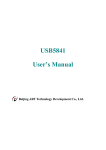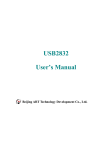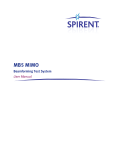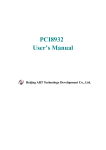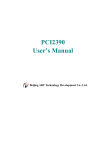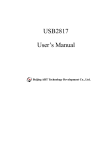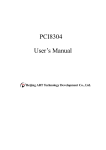Download USB5932 User`s Manual
Transcript
USB5932 Data Acquisition V6.011 USB5932 User’s Manual Beijing ART Technology Development Co., Ltd. BUY ONLINE at art-control.com/englishs or CALL+86-10-51289836(CN) 1 USB5932 Data Acquisition V6.011 Contents Contents ................................................................................................................................................................................2 Chapter 1 Overview ..............................................................................................................................................................3 Chapter 2 Components Layout Diagram and a Brief Description .......................................................................................5 2.1 The Main Component Layout Diagram ..................................................................................................................5 2.2 The Function Description for the Main Component ...............................................................................................5 2.2.1 Signal Input and Output Connectors ............................................................................................................5 2.2.2 Potentiometer ...............................................................................................................................................5 2.2.3 Jumper..........................................................................................................................................................6 2.2.4 Physical ID of DIP Switch ...........................................................................................................................6 2.2.5 Status indicator.............................................................................................................................................7 Chapter 3 Signal Connectors................................................................................................................................................8 3.1 The Definition of Analog Output Connectors .........................................................................................................8 3.2 The Definition of Digital Inputs/Outputs Connectors.............................................................................................9 Chapter 4 Connection Ways for Each Signal......................................................................................................................10 4.2 Analog Input Connection Mode ............................................................................................................................10 4.2 Digital Input/Output Connection Mode ................................................................................................................10 4.3 Digital Input/Output Connection Mode ................................................................................................................10 Chapter 5 Timer/Counter Function.....................................................................................................................................11 Chapter 6 Notes, Calibration and Warranty Policy............................................................................................................14 6.1 Notes .....................................................................................................................................................................14 6.2 Analog Signal Output Calibration.........................................................................................................................14 6.3 DA Use..................................................................................................................................................................14 6.4 Warranty Policy.....................................................................................................................................................14 Products Rapid Installation and Self-check ........................................................................................................................16 Rapid Installation ........................................................................................................................................................16 Self-check ...................................................................................................................................................................16 Delete Wrong Installation ...........................................................................................................................................16 BUY ONLINE at art-control.com/englishs or CALL+86-10-51289836(CN) 2 USB5932 Data Acquisition V6.011 Chapter 1 Overview USB5932 data acquisition board is compatible with USB bus, may access the computer via USB cable, which constitutes the laboratory, product quality testing center, field monitoring and control, medical equipment and other fields’ data acquisition, waveform analysis and processing system, it can also constitute the industrial production process control monitoring system. And it has a small size, plug-and-play characteristics, so it is the best choice for portable system. Unpacking Checklist Check the shipping carton for any damage. If the shipping carton and contents are damaged, notify the local dealer or sales for a replacement. Retain the shipping carton and packing material for inspection by the dealer. Check for the following items in the package. If there are any missing items, contact your local dealer or sales. ¾ USB5932 Data Acquisition Board ¾ ART Disk a) user’s manual (pdf) b) drive c) catalog ¾ Warranty Card FEATURES Analog Output ¾ ¾ ¾ ¾ ¾ ¾ ¾ ¾ Output Range: ±10.8V, ±10V, ±5V, 0~10.8V, 0~10V, 0~5V 12-bit resolution Update Rate: 100KHz Setup time: 10μs Number of Channels: 8 Non-linear error: ±1LSB(Maximum) Operating Temperature Range: 0℃~50℃ Storage Temperature Range: -20℃~70℃ Digital Input ¾ ¾ ¾ ¾ ¾ Channel No.: 6-channel Electric Standard: TTL compatible Maximum sink current:: <0.5V High Level: ≧2V Low Level: ≦0.8V Digital Output ¾ ¾ ¾ ¾ ¾ Channel No.: 6-channel Electrical Standard: TTL compatible High Level: ≧2.4V Low Level: ≦0.5V Power-on output: low level BUY ONLINE at art-control.com/englishs or CALL+86-10-51289836(CN) 3 USB5932 Data Acquisition V6.011 Counter/Timer ¾ ¾ ¾ ¾ ¾ ¾ One 32-bit down counter Counter Mode: 6 modes Input and Output Standard Electrical: TTL level Clock Source: 1Hz~10MHz Gate: rising edge, falling edge, high level, low level Counter Output: high level, low level Other Features Board Clock Oscillation: 10MHz Board Dimension: 95.5mm (L) * 98.8mm (W) *16mm (H) BUY ONLINE at art-control.com/englishs or CALL+86-10-51289836(CN) 4 USB5932 Data Acquisition V6.011 Chapter 2 Components Layout Diagram and a Brief Description 2.1 The Main Component Layout Diagram 2.2 The Function Description for the Main Component 2.2.1 Signal Input and Output Connectors P2: Analog signal inputs connector P1, P3: Digital inputs/outputs, counter inputs/outputs connectors 2.2.2 Potentiometer RP1: RP6: RP2: RP5: AO0 analog signal output zero-point adjustment potentiometer AO1 analog signal output zero-point adjustment potentiometer AO2 analog signal output zero-point adjustment potentiometer AO3 analog signal output zero-point adjustment potentiometer BUY ONLINE at art-control.com/englishs or CALL+86-10-51289836(CN) 5 USB5932 Data Acquisition V6.011 RP14: AO4 analog signal output zero-point adjustment potentiometer RP9: AO5 analog signal output zero-point adjustment potentiometer RP13: AO6 analog signal output zero-point adjustment potentiometer RP10: AO7 analog signal output zero-point adjustment potentiometer RP3: AO0 analog signal output full-scale adjustment potentiometer RP8: AO1 analog signal output full-scale adjustment potentiometer RP4: AO2 analog signal output full-scale adjustment potentiometer RP7: AO3 analog signal output full-scale adjustment potentiometer RP16: AO4 analog signal output full-scale adjustment potentiometer RP11: AO5 analog signal output full-scale adjustment potentiometer RP15: AO6 analog signal output full-scale adjustment potentiometer RP12: AO7 analog signal output full-scale adjustment potentiometer 2.2.3 Jumper JPW1: Load the USB controller program, by default, 1-2 pins are shorted. 2.2.4 Physical ID of DIP Switch DID1: Set physical ID number. When the PC is installed more than one USB5932 , you can use the DIP switch to set a physical ID number for each board, which makes it very convenient for users to distinguish and visit each board in the progress of the hardware configuration and software programming. The following four-place numbers are expressed by the binary system: When DIP switch points to "ON", that means "1", and when it points to the other side, that means "0." As they are shown in the following diagrams: place "ID3" is the high place."ID0" is the low place, and the black part in the diagram represents the location of the switch. (Test software of the company often use the logic ID management equipments and at this moment the physical ID DIP switch is invalid. If you want to use more than one kind of the equipments in one and the same system at the same time, please use the physical ID as much as possible). ON ID3 ID2 ID1 ID0 ON DID1 1 2 3 4 The above chart shows"1111", so it means that the physical ID is 15. ON ID3 ID2 ID1 ID0 ON DID1 1 2 3 4 The above chart shows"0111", so it means that the physical ID is 7. ON ID3 ID2 ID1 ID0 ON DID1 1 2 3 4 The above chart shows"0101", so it means that the physical ID is 5. BUY ONLINE at art-control.com/englishs or CALL+86-10-51289836(CN) 6 USB5932 Data Acquisition V6.011 ID3 OFF(0) ID2 OFF(0) ID1 OFF(0) ID0 OFF(0) 0 0 OFF(0) OFF(0) OFF(0) ON(1) 1 1 OFF(0) OFF(0) ON(1) OFF(0) 2 2 OFF(0) OFF(0) ON(1) 3 3 OFF(0) OFF(0) 4 4 OFF(0) ON(1) ON(1) ON(1) OFF(0) ON(1) OFF(0) 5 ON(1) OFF(0) ON(1) 5 OFF(0) 6 6 OFF(0) ON(1) ON(1) 7 7 ON(1) OFF(0) OFF(0) ON(1) OFF(0) 8 8 ON(1) OFF(0) OFF(0) 9 9 ON(1) OFF(0) ON(1) A 10 ON(1) OFF(0) ON(1) B 11 ON(1) ON(1) OFF(0) C 12 ON(1) ON(1) OFF(0) D 13 ON(1) ON(1) ON(1) ON(1) OFF(0) E 14 ON(1) ON(1) ON(1) ON(1) F 15 ON(1) OFF(0) ON(1) OFF(0) Physical ID(Hex) Physical ID(Dec) 2.2.5 Status indicator LED3.3V: 3.3V power indicator, on for normal condition. BUY ONLINE at art-control.com/englishs or CALL+86-10-51289836(CN) 7 USB5932 Data Acquisition V6.011 Chapter 3 Signal Connectors 3.1 The Definition of Analog Output Connectors Pin definition of P2 AO0 10 AO1 AO2 AO3 AO4 P2 AO5 AO6 AO7 AGND AGND 1 Pin definition about analog outputs Pin name Pin feature Pin function definition AO0-AO7 Output Analog output pins AGND GND Analog signals ground BUY ONLINE at art-control.com/englishs or CALL+86-10-51289836(CN) 8 USB5932 Data Acquisition V6.011 3.2 The Definition of Digital Inputs/Outputs Connectors Pin definition of P1 1 DI0 DI1 DI2 DI3 DI4 P1 DI5 DO0 DO1 DO2 DO3 10 Pin definition of P3 DO4 1 DO5 DGND CLK2M P3 OUT GATE CLK +5V 8 Pin definition about digital inputs/output Pin name Type Pin function definition DI0~DI5 Input Digital input, reference ground is DGND. DO0~DO5 Output Digital output. +5V Output Output 5V voltage. CLK2M Output On-board 2.5MHz clock oscillator pulse output, output cycle 0.4 microseconds, provides the clock source signal for CLK CLK Input Timer/counter clock source input, reference ground is DGND. GATE Input Timer/counter gate input, reference ground is DGND. OUT Output Timer/Counter output, the default is counter output, reference ground is DGND. When clock output is forbidden, DGND Digital ground. Ground reference for Digital circuitry. This DGND pin should be connected to the system’s DGND plane. BUY ONLINE at art-control.com/englishs or CALL+86-10-51289836(CN) 9 USB5932 Data Acquisition V6.011 Chapter 4 Connection Ways for Each Signal 4.2 Analog Input Connection Mode Figure 4.1 analog signal output connection 4.2 Digital Input/Output Connection Mode Figure 4.2 digital signal input connection Figure 4.3 digital signal output connection 4.3 Digital Input/Output Connection Mode Figure 4.4 clock input / output and trigger signal connection BUY ONLINE at art-control.com/englishs or CALL+86-10-51289836(CN) 10 USB5932 Data Acquisition V6.011 Chapter 5 Timer/Counter Function Mode 0: Interrupt on terminal count In this mode, when the initial value assigned, if GATE is high level, the counter immediately to count by subtracting 1, and the output becomes low level. When the value turns to 0, the output becomes and keeps high level until given the initial value or reset. If a counter which is counting is given a new value, the counter recount from the new initial value. GATE=1 enables counting; GATE=0 disables counting. Time diagram is shown in Figure 1. Figure 1 Mode 1: Hardware retriggerable one-shot The mode can work under the role of GATE of gating signal. When given the initial value, OUT becomes high level, if “GATE” signal has a rising edge, the counter immediately begins to count, at this time the output OUT turns into low level. When the count ends, in other word, the count value turns to 0, the output OUT turns to high level, the output width of one-shot is deceived by initial value. If a counter which is counting is given a new value, it does not affect the current operation. Only when the value turns to “0” and there is a “GATE” rising edge, the counter will begin to count from the new value. If there is a “GATE” rising edge when the counter is working, the current counting is stopped and re-start counting from the initial value. So the output single pulse has been widened Time diagram is shown in Figure 2. Figure 2 BUY ONLINE at art-control.com/englishs or CALL+86-10-51289836(CN) 11 USB5932 Data Acquisition V6.011 Mode 2: Rate Generator Set this mode, the counter loads the initial value of n, start counting from the (n-1), OUT becomes high level, when the count value reaches 0, the OUT becomes low level. After a CLK cycle, OUT restore high level, and then the counter automatically load the initial value n, restart counting from the (n-1). Therefore, the output terminal will continue to output negative pulse, whose width is equal to one clock cycle, the clock number between the two negative pulses is equal to the initial value that is given to the counter. Set a new initial value during a counting period, the counter start a new count cycle next time. GATE=1 enables counting; GATE=0 disables counting. Time diagram is shown in Figure 3. Figure 3 Mode 3: Square wave mode Similar to Mode 2, the counter loads the initial value of n, start counting from the (n-1) when the signal of GATE has a rising edge, timer/counter begins to count by subtracting “1” each time. The “OUT” terminal output high level when the count value is more than half of the initial count value, and it turn to low level when the count value is less than half of the initial value. If the initial count value n is an even number, then output 1:1 square wave, if the initial count value a is odd number, the output has remained high level during the previous (n+1)/2 count period, but the output becomes low level during the post (n-1)/2 count period, that is high level has one clock cycle than low level. Set a new initial value during a counting period, the counter start a new count cycle next time. When GATE = 0, the count is prohibited, when GATE = 1, the count is permitted. Time diagram is shown in Figure 4. Figure 4 Mode 4: Software triggered strobe BUY ONLINE at art-control.com/englishs or CALL+86-10-51289836(CN) 12 USB5932 Data Acquisition V6.011 Under this mode, the counter starts counting after is given the initial value n, and OUT becomes high level. When the count value becomes 0, it immediately outputs a negative pulse which is equal to the width of one clock cycle. If given a new count value when counting, it will be effective immediately. GATE=1 enables counting; GATE=0 disables counting. Time diagram is shown in figure 5. Figure 5 Mode 5: Software triggered strobe Under this mode, when the signal of GATE is on the rising edge, the counter starts to count (so it is called hardware trigger), the output OUT has remained high level. When the count value becomes 0, it outputs a negative pulse which is equal to the width of one clock cycle. And then the rising edge of GATE signal can re-trigger, the counter starts to count from the initial count value again, in the count period, the output has remained high level. If a counter which is counting is given a new value, it does not affect the current operation. Only when the value turns to “0” and there is a “GATE” rising edge, the counter will begin to count from the new value. Time diagram is shown in figure 6. Figure 6 BUY ONLINE at art-control.com/englishs or CALL+86-10-51289836(CN) 13 USB5932 Data Acquisition V6.011 Chapter 6 Notes, Calibration and Warranty Policy 6.1 Notes In our products’ packing, user can find a user manual, a USB5932 module and a quality guarantee card. Users must keep quality guarantee card carefully, if the products have some problems and need repairing, please send products together with quality guarantee card to ART, we will provide good after-sale service and solve the problem as quickly as we can. When using USB5932, in order to prevent the IC (chip) from electrostatic harm, please do not touch IC (chip) in the front panel of USB5932 module. 6.2 Analog Signal Output Calibration In the manual, we introduce how to calibrate USB5932 in ±5V input range; calibrations of other output ranges are similar. 1)Connect the ground of the digital voltage meter to any AGND. Connect the input side of the voltage meter to the DA input channel which needs calibration. Run USB5932 test procedure under Windows, select the DA output detection. 2) Set the analog value to 2048. Then adjust potentiometer RP1 to make the output of AO0 is 0.000V. Adjust potentiometer RP6, RP2, RP5, RP14, RP9, RP13 to make the outputs of AO1~AO7 are 0.000V. 3)Set the analog value to 4095. Adjust potentiometer RP3 to make the output of AO0 is 4997.55mV. Adjust potentiometer RP8, RP7, RP16, RP11, RP15, RP12 to make the outputs of AO1~AO7 are 4997.55mV. 4)Repeat steps above until meet the requirement. 6.3 DA Use In demonstration program, the continuous output interval of waveform output can not be carried out; the main objective is to test the strength of DA output. 6.4 Warranty Policy Thank you for choosing ART. To understand your rights and enjoy all the after-sales services we offer, please read the following carefully. 1. Before using ART’s products please read the user manual and follow the instructions exactly. When sending in damaged products for repair, please attach an RMA application form which can be downloaded from: www.art-control.com. 2. All ART products come with a limited two-year warranty: ¾ The warranty period starts on the day the product is shipped from ART’s factory ¾ For products containing storage devices (hard drives, flash cards, etc.), please back up your data before sending them for repair. ART is not responsible for any loss of data. BUY ONLINE at art-control.com/englishs or CALL+86-10-51289836(CN) 14 USB5932 Data Acquisition V6.011 ¾ Please ensure the use of properly licensed software with our systems. ART does not condone the use of pirated software and will not service systems using such software. ART will not be held legally responsible for products shipped with unlicensed software installed by the user. 3. Our repair service is not covered by ART's guarantee in the following situations: ¾ Damage caused by not following instructions in the User's Manual. ¾ Damage caused by carelessness on the user's part during product transportation. ¾ Damage caused by unsuitable storage environments (i.e. high temperatures, high humidity, or volatile chemicals). ¾ Damage from improper repair by unauthorized ART technicians. ¾ Products with altered and/or damaged serial numbers are not entitled to our service. 4. Customers are responsible for shipping costs to transport damaged products to our company or sales office. 5. To ensure the speed and quality of product repair, please download an RMA application form from our company website. BUY ONLINE at art-control.com/englishs or CALL+86-10-51289836(CN) 15 USB5932 Data Acquisition V6.011 Products Rapid Installation and Self-check Rapid Installation Product-driven procedure is the operating system adaptive installation mode. After inserting the disc, you can select the appropriate board type on the pop-up interface, click the button【driver installation】; or select CD-ROM drive in Resource Explorer, locate the product catalog and enter into the APP folder, and implement Setup.exe file. After the installation, pop-up CD-ROM, shut off your computer, insert the PCI card. If it is a USB product, it can be directly inserted into the device. When the system prompts that it finds a new hardware, you do not specify a drive path, the operating system can automatically look up it from the system directory, and then you can complete the installation. Self-check At this moment, there should be installation information of the installed device in the Device Manager (when the device does not work, you can check this item.). Open "Start -> Programs -> ART Demonstration Monitoring and Control System -> Corresponding Board -> Advanced Testing Presentation System", the program is a standard testing procedure. Based on the specification of Pin definition, connect the signal acquisition data and test whether AD is normal or not. Connect the input pins to the corresponding output pins and use the testing procedure to test whether the switch is normal or not. Delete Wrong Installation When you select the wrong drive, or viruses lead to driver error, you can carry out the following operations: In Resource Explorer, open CD-ROM drive, run Others-> SUPPORT-> PCI.bat procedures, and delete the hardware information that relevant to our boards, and then carry out the process of section I all over again, we can complete the new installation. BUY ONLINE at art-control.com/englishs or CALL+86-10-51289836(CN) 16

















